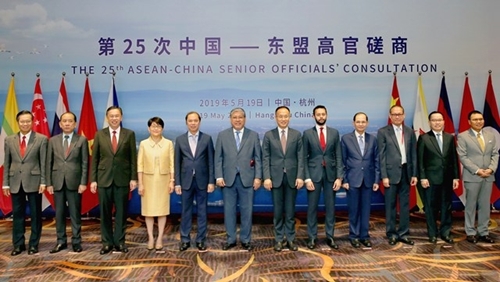The Vietnamese delegation was led by Deputy Foreign Minister Nguyen Quoc Dung, who on behalf of ASEAN delivered an introductory speech on political-security cooperation, putting forth important orientations for enhancing ASEAN-China ties in this regard.
At the event, participants applauded the strides in implementing the instructions issued by the 21st ASEAN-China Summit in Singapore last November and the ASEAN-China Strategic Partnership Vision 2030.
With 47 cooperation mechanisms in various spheres, the ASEAN-China strategic partnership has been being carried out strongly, they noted.
    |
 |
|
Vietnamese Deputy Foreign Minister Nguyen Quoc Dung (fifth, left) and other officials pose for a photo at the ASEAN-China Senior Officials' Consultation in Hangzhou on May 19. |
China has continually been the top trade partner of ASEAN with bilateral trade reaching 436.8 billion USD in 2017, accounting for 17 percent of the bloc’s total trade. With 11.3 billion USD of investment capital poured in ASEAN countries in 2017, China is also the third biggest investor of ASEAN.
The number of tourists between the two sides has always surpassed 10 million each year. Many people-to-people and youth exchanges, along with educational, cultural and media exchanges, have been held such as the ASEAN-China Education Cooperation Week, the ASEAN-China Youth Camp 2018, and the ASEAN-China Year of Media Exchange 2019.
Regarding orientations for future cooperation, the two sides agreed to press on with realizing the ASEAN-China Strategic Partnership Vision 2030. Accordingly, they will realize the ASEAN-China Plan of Action 2016-2020 and strive to raise bilateral trade to 1 trillion USD and bilateral investment to 150 billion USD in 2020.
They will also focus their cooperation on digital economy, e-commerce, cyber security, connectivity promotion, infrastructure building, transportation, development of the Greater Mekong Sub-region, support for small- and medium-sized enterprises, agriculture, innovation, and negotiations on the Regional Comprehensive Economic Partnership (RCEP).
China presented cooperation proposals in terms of smart city building, media exchange, and connection of its Belt and Road Initiative with ASEAN’s development plans.
Discussing the regional and international situation, ASEAN and China affirmed the necessity to build and consolidate an open, transparent, inclusive and rules-based regional architecture.
China voiced its support for the grouping’s central role and noted its hope for a united and unanimous ASEAN and a strong ASEAN Community. ASEAN countries also highly valued China’s role and participation in ASEAN-led forums. They hoped that China will continue making active and responsible contributions to peace, stability and sustainable development in the region.
The event also recognized the outcomes of the ASEAN-China senior official’s meeting on the implementation of the Declaration on the Conduct of Parties in the East Sea (DOC), along with the progress in building a Code of Conduct (COC) in the waters.
Participants agreed on the need to fully implement the DOC and soon finalize an efficient and substantive COC supported by the international community.
Many countries stressed the importance of peace, stability, security, safety and freedom of navigation and aviation in the East Sea. They called on relevant parties to exercise self-restraint, cooperate to build trust, avoid complicating the situation, and resolve disputes by peaceful means on the basis on international law, including the 1982 United Nations Convention on the Law of the Sea.
Source: VNA